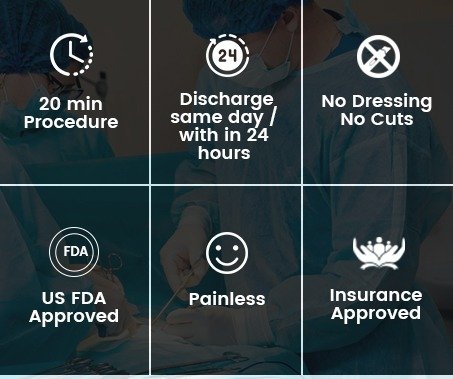Laser treatment, also known as laser ablation for anal fistula, is a safe and effective surgical technique that helps treat an anal fistula. It is a minimally invasive procedure that offers several benefits. Here’s everything you need to know about laser treatment for anal fistula in Agra.
Overview:
Laser treatment for anal fistula is an advanced surgical procedure used to treat anal fistulas. These fistulas are small tunnels formed beneath the skin, connecting the bowel to the anus. They often result from infections, injury, or congenital defects. Symptoms include pain in the anus, pus or blood in the stools, weight loss, and swelling in the anal area. Laser treatment offers a stitch-less and painless solution with minimal post-operative complications.
Laser Treatment Procedure:
Laser treatment, also known as FiLAC (fistula-tract laser closure), is a sphincter muscle-sparing procedure. Laser beams are directed at the fistula’s opening, generating heat energy to shrink the abnormal tissues within the tunnel. Different wavelengths of lasers are used, with varying tissue penetration powers. The abnormal tissues absorb the light energy, converting it to heat energy, which destroys the abnormal cells while sparing the normal ones. Typically, the tissues within the anal fistula are ablated through vaporization.
About Dr. Shavez Khan – Laser Fistula Specialist in Agra: Dr. Shavez Khan is a renowned specialist in laser treatment for anal fistula in Agra. With extensive experience and expertise in the field, Dr. Khan offers state-of-the-art laser procedures for effective treatment of anal fistulas. Patients can trust Dr. Khan for personalized care and successful outcomes.
Laser treatment for anal fistula offers several advantages over traditional surgical methods, including minimal pain, faster recovery, and reduced risk of complications. If you’re suffering from an anal fistula, consider consulting Dr. Shavez Khan in Agra for advanced laser treatment options.
When is Laser Treatment for Anal Fistula Recommended?
An anal fistula, an abnormal tube formed between the bowel and the outer anal skin, often results from an unhealed anal abscess. It is classified into four grades, ranging from low to high fistulas with single or multiple tracts.
Laser treatment for anal fistula is typically recommended under the following circumstances:
Failure of Conventional Methods: When other traditional surgical methods have been unsuccessful in treating the anal fistula.
Severe Infection: In cases where the anal fistula is severely infected, leading to pain, high-grade fever (>103°F), and prominent blood and pus discharge in stools.
Quick Recovery Needed: For individuals with busy schedules who need to resume work swiftly, as laser surgery offers a rapid recovery.
Grade II, III, and IV Anal Fistula: Laser treatment is suitable for anal fistulas classified as Grade II, III, or IV.
How to Prepare For Laser Treatment for Anal Fistula?
Preparation for laser treatment for anal fistula involves several steps to ensure a successful procedure:
Medical Evaluation: A proctologist will evaluate your symptoms, medical history, and conduct physical examinations and diagnostic tests to determine the type and grade of the fistula.
Medical History Discussion: Your doctor will inquire about your medical history, including any pre-existing conditions such as diabetes, hypertension, or previous injuries or surgeries that may contribute to the development of an anal fistula.
Medication Review: Provide details about any medications you are currently taking, including blood thinners, anti-inflammatory drugs, antidepressants, or herbal supplements, as they may impact the treatment process.
Lifestyle Habits: Inform your doctor about any lifestyle habits such as smoking or alcohol consumption, as they can affect your recovery.
Physical/Clinical Examination:
During the physical or clinical examination for an anal fistula, your doctor will conduct several assessments to evaluate your symptoms and determine the presence of the fistula. These assessments may include:
Visual Inspection: Your doctor will visually inspect the anal area for any signs of swelling, redness, or discharge.
Digital Examination: Using gloved and lubricated fingers, your doctor will perform a digital examination to:
- Check for the presence of the fistula tract.
- Assess tenderness around the anal area.
- Feel for any swelling or lumps.
- Observe for bleeding from the anal area during the insertion of the finger.
Diagnostic Tests:
In addition to the physical examination, your doctor may recommend several diagnostic tests to further evaluate the anal fistula and assess your overall health. These tests may include:
Anoscopy: This involves examining the anal canal using a special scope to visualize the interior and detect the presence of a fistula.
MRI (Magnetic Resonance Imaging): MRI imaging may be recommended to obtain detailed images of the affected organs or tissues and confirm the presence of a fistula.
Colonoscopy: A thin, flexible tube with a light source and camera (endoscope) may be inserted into the body to examine internal organs and detect gastrointestinal fistulas.
Preoperative Profile: Set of blood tests that are conducted before an operation. Such tests are determined according to your age, your present health condition, and other associated diseases you might have.
Pre-Procedure Preparation:
After conducting the necessary physical examinations and diagnostic tests, your proctologist will determine the most appropriate surgical approach for treating the anal fistula. If laser fistula treatment is recommended, you will receive specific instructions to prepare for the procedure. These instructions may include:
- Discontinuing medications, such as blood thinners, at least 2 to 3 weeks before the surgery.
- Avoiding smoking and alcoholconsumption for at least 2 weeks prior to the procedure.
- Planning time off from work for a recovery period of 4 to 5 days post-surgery.
- Fasting for 8 to 12 hours before the surgery, as it is typically performed under general anesthesia.
- Arranging for transportation home after the procedure, as you may experience dizziness following the anesthesia’s effects.
How Does the Procedure Work?
Preparation:
- You will be taken to a laser-equipped room designated for the procedure.
- Any excess hair around the surgical site will be shaved by your nurse, if present.
- The anal area will be thoroughly disinfected using an antiseptic solution such as betadine to remove surface contaminants and minimize the risk of infection.
- An intravenous (IV) line will be inserted through a thin needle to administer fluids, and antibiotics.
- Your surgeon will mark the area around the anus where the laser probe will be inserted.
Anesthesia:
The anesthesiologist will administer spinal anesthesia (SA).
Your vital signs, including blood pressure, heart rate, pulse, and oxygen levels, will be continuously monitored throughout the procedure.
Procedure:
- A flexible, round, laser-radiating fiber-optic probe will be carefully inserted into the fistula tract from the outside under the guidance of specialized equipment.
- The laser light emitted from the probe is absorbed by the abnormal tissue lining of the anal fistula, causing it to convert to heat energy.
- This heat energy vaporizes (electrocauterizes) the tissue lining and effectively shrinks the cells within the anal fistula, promoting closure.
Wound Closure:
As a result of the laser treatment, the fistula lining shrinks, and the fistula tract contracts, leading to the sealing of the external opening.
Your surgeon may pack the surgical site with a medicated dressing to promote healing, which will be removed before you are discharged.
The entire laser procedure typically takes around 15 to 30 minutes to complete, depending on the complexity of the anal fistula and the extent of treatment required.
Laser treatment for anal fistula offers several advantages, including
- Minimal tissue damage,
- Reduced post-operative pain, and
- Faster recovery compared to traditional surgical techniques.
Always follow your doctor’s post-operative instructions carefully to ensure optimal healing and outcomes.
What to Expect After the Procedure?
Once the procedure is completed, you will likely spend 2 to 3 hours in a recovery room until your vitals are stabilized.
In the Hospital:
- You may take a few hours to regain consciousness and begin moving around.
- Mild pain, soreness, and discomfort are common as the effects of anesthesia gradually wear off.
- Initially, you will only be allowed sips of water, gradually advancing to fluids like juices.
- By the end of the day (approximately 5 to 6 hours post-procedure), you will be discharged to go home.
- Your surgical pack or dressing will be removed before you leave the hospital.
- Your doctor will prescribe painkillers, laxatives, and antibiotics to manage pain, facilitate bowel movements, and prevent infections.
At Home:
- Resting is essential upon returning home to allow your body sufficient time to heal.
- Encourage light movement to prevent blood clot formation, but avoid strenuous activities.
- Sitz baths (sitting in a tub of warm water) for 15 to 20 minutes, several times daily, can help alleviate discomfort.
- Maintain a healthy, fiber-rich diet to prevent constipation, avoiding spicy, fatty, and junk foods.
- Stay hydrated by consuming 1 to 2 liters of fluids daily, including water, juice, and soups.
- Use prescribed laxatives (stool softeners) to ease bowel movements.
- Avoid heavy lifting and strenuous exercises for at least 3 weeks.
- You may resume work and normal activities within 5 to 7 days post-surgery.
- Complete recovery typically takes around 2 weeks following laser treatment.
Benefits and Risks of Laser Treatment for Anal Fistula:
Laser surgery for an anal fistula offers several benefits over conventional open surgery:
Benefits:
- Minimal incisions, often stitch-less, leading to less scarring and pain.
- Painless procedure with quick healing and minimal trauma to surrounding tissues.
- Reduced risk of bleeding and damage to sphincter muscles.
Risks:
- Allergic reactions to anesthesia, although rare, can occur.
- Secondary infections around the surgical site are possible, requiring prompt medical attention.
- Mild bruising around the anal region may occur but is generally temporary and resolves on its own.







